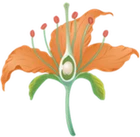Plant Worksheets

Plant worksheets and life cycle of a plant worksheets that are designed for high school, middle school, and elementary school life science teachers are downloadable here for free. The parts of the flower labs where students learn plant anatomy along with plant life cycles. Click the Free Lesson Plan (PDF) link below or become a member to get access to the answer key and editable file. Free plant curriculum includes:
-

Plant Anatomy - The Parts of A Perfect Flower Free Lesson Plan
Middle School Lab
Upon completion of this lab activity, the student will be able to: (1) identify each flower part. (2) explain the role of each flower part.NGSS Standard
MS-LS1-4 (Animal Plant Structures)
Published by Guinevere Miller
-

Plant Anatomy - Which sex is it? Free Lesson Plan
Middle School Lab
Students will be able to identify the parts of a flower and tell whether or not the flower has both male and female sex organs (perfect) or just one sex organ (imperfect).NGSS Standard
MS-LS1-4 (Animal Plant Structures)
MS-LS3-2 (Types of Reproduction)
Published by Pamela Moy
-


Plant Growth Germination Lab  Free Lesson Plan (PDF)
Free Lesson Plan (PDF)
Lesson Plan (DOCX) & Answer Key with Membership
High School Lab
The goal of this basic lab is break the misconception that photosynthesis is how plants grow. Students should also learn that plants grow by cell division. Students will be able to move past the misconception that plants use photosynthesis, not cell division, to grow.NGSS Standard
HS-LS1-4
HS-LS1-5
Common Core Standard
RST 9.10.3, 9.10.5, 9.10.7, WST 9.10.1b, 9.10.1e, 9.10.2a, 9.10.7, 9.10.9
Published by NGSS Life Science
-

Structure of Seeds and Effects of Fertilizer on Plant Growth Free Lesson Plan
Elementary School Lab
Students learn about the structural components of seeds of higher plants and the functions of each of these components. Students also investigate how fertilizer affects the growth of plants, particularly of seedlings, and how this relates to seed structure.NGSS Standard
MS-LS1-4 (Animal Plant Structures)
5-LS2-1 (Movement of Matter)
5-LS1-1 (Plant Nutrition)
4-LS1-1 (Plant Animal Structures)
Published by Ben Stark
-

Plant Anatomy Lab - What Parts are Food? Free Student Handout
Free Teacher Notes
Middle School Lab
In this plant anatomy lab, students learn about the structure of angiosperm plants and their diversity of plant forms. Students make claims about which parts of plants, fruits, and vegetables come from.NGSS Standard
MS-LS1-4 (Animal Plant Structures)
Published by Ingrid Waldron and Jennifer Doherty
-

Plant Life Cycle - Structure and Function of Seeds Free Lesson Plan
Elementary School Lab
In the following exercises the structure of a seed (particularly the embryo) is observed and two experiments are performed to show the function of the cotyledons in providing nourishment to the plant during the early times after germination.NGSS Standard
MS-LS1-4 (Animal Plant Structures)
MS-LS3-2 (Types of Reproduction)
4-LS1-1 (Plant Animal Structures)
3-LS1-1 (Life Cycles)
2-LS2-2 (Seed & Pollination)
Published by Ben Stark
-

Water Transpiration Plant Lab Free Lesson Plan
High School Lab
Students will use the concepts of adhesion and cohesion to understand the process of transpiration in plants to transport water through the plant. The form and function of stomata are also covered.NGSS Standard
MS-LS1-4 (Animal Plant Structures)
Published by Matthew Gibson
